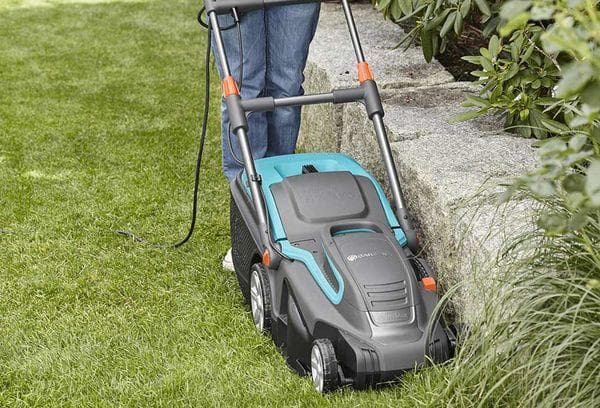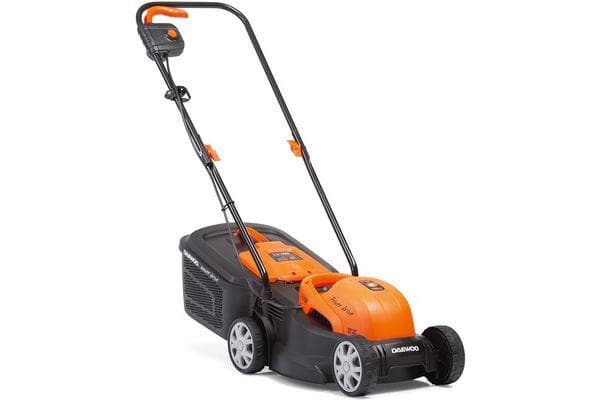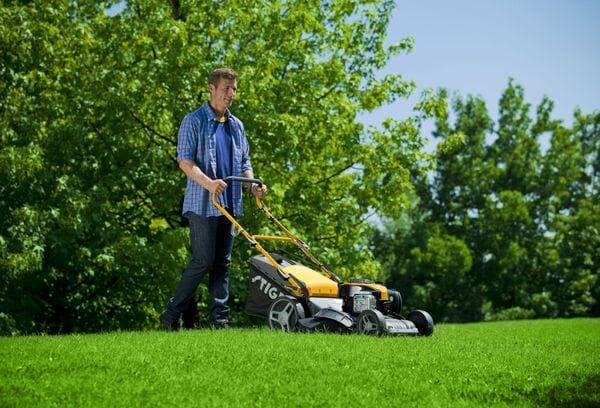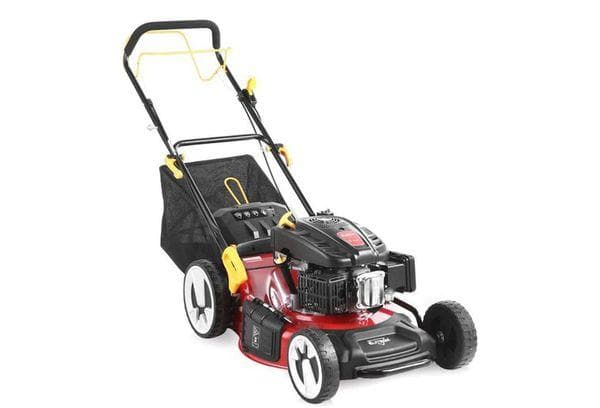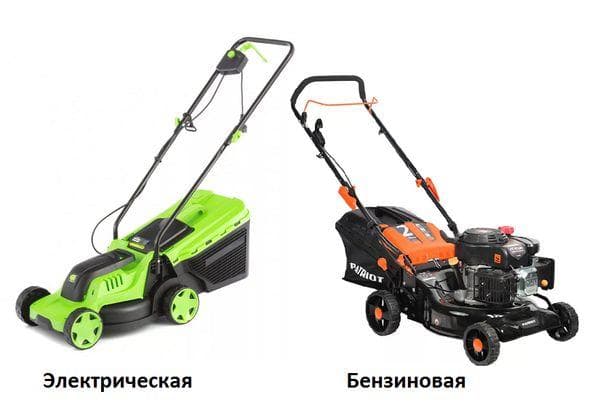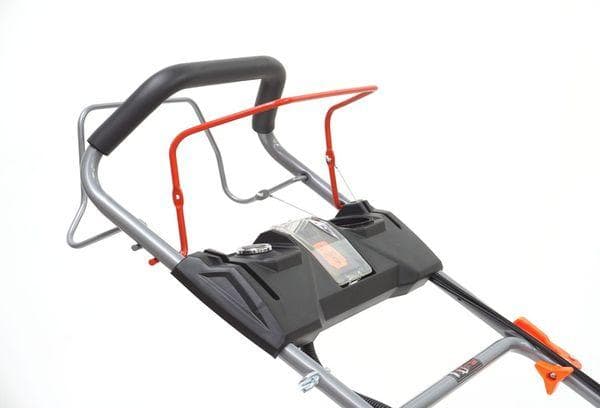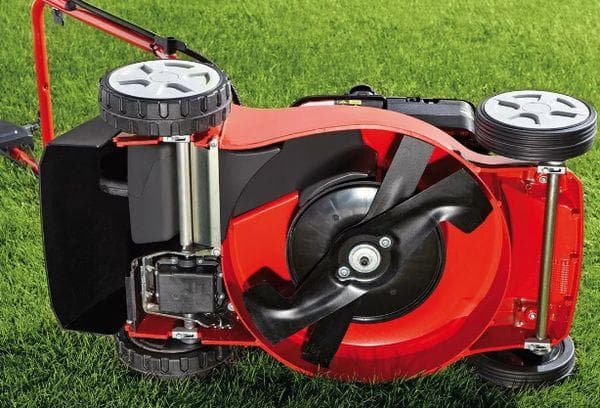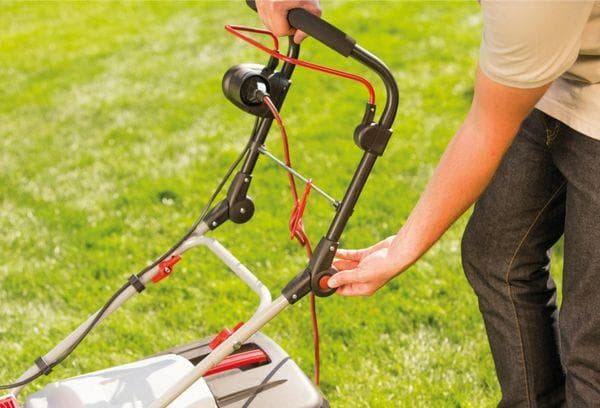Lawn mower: electric or gas? How not to make a mistake in choosing
Content:
The braid is a thing of the past century, the trimmer hurts your hands, which means it’s time to decide. Which lawn mower is better, gas or electric? What is the difference between them, what advantages and disadvantages do different models have?
Let's figure it out now.
Gasoline and electric mower - what's the difference?
The answer is obvious - in the engine.
Electric lawn mowers have a powerful electric motor. Such units are powered from the network, which means there must be a source of electricity nearby.
Important. Before plugging in your electric mower, make sure you have good wiring. This unit creates a large load on the network. Old and weak wiring will not hold up. At best, your traffic jams will blow out; at worst, a fire will start.

The petrol model is powered by a petrol engine. You will have to buy fuel at a gas station and fill it into the gas tank of the mower.
Advice.Lawn mowers are designed for mowing short grass with thin stems. If your area is a jungle, use a trimmer or mower.
Comparative characteristics table
Gasoline and electric models are different. Evaluate these differences.
| Evaluation criterion | Gasoline models | Electric mowers |
| Bevel height | Mid-priced models offer up to 9 bevel levels. The unit will mow a lawn up to 10 cm high. But if the grass has grown more than 15 cm, the mower will not cope. | Similar characteristics |
| Bevel width | Up to 1 meter, sometimes more. | Up to 50 cm. |
| Power | Up to 16 “horses”. | Up to 1000 kW, occasionally more. |
| Weight | From 20 to 50 kg. | From 10 to 25 kg. |
| Duration of continuous operation | Until the tank is empty. | About 15 minutes, then a break of the same length. |
| Lawn area | The average model mows lawns up to 6000 square meters. m. | The high-performance model will mow 900 square meters. m. Average - about 600-700 sq. m. m. |
| Price | From 10 to 150 thousand rubles. | From 5 to 70 thousand rubles. |
These are different units, and they are suitable for different conditions.
Electric Lawn Mower: Pros and Cons
Mobile, lightweight, convenient - this is an electric mower in three words.
pros
Electric models have four key advantages.
- Copes with difficult terrain.
The electric mower has a weak engine - this is an advantage in hilly areas with difficult terrain. If a low-powered mower hits an obstacle, it will simply stop. The same goes for stones or other hard objects that get caught in the grass. If a piece of brick gets into the mechanism, the weak model will stall.
Remove the stone and the mower will start working again. And a powerful model will try to “move down” the obstacle. The motor will spin the blades, increasing pressure on the blades and causing them to bend.Curved cutting elements will distort the shaft and break the bushing - and this is a major repair. Expensive and complicated.
- No need to waste time on maintenance. An electric mower is like a vacuum cleaner: plug the cord into the outlet and go!
- Low weight. Even a woman can handle such a unit. If you do a lot of lawn work, an electric mower is your option.
- Affordable price. Electric models are 2 times cheaper than gasoline ones.
Minuses
This model has many disadvantages.
- Low power. You cannot power a powerful motor from the mains, which means electric models are rather weak. Most electric mowers operate in the “15 minutes mow – 15 rest” mode. If you operate them without interruption, the engine will overheat and burn out. Such models are not suitable for processing a large area.
- Spacious areas cannot be processed. The length of a standard electric mower cord is about 20 meters, sometimes a little more. This is not enough to mow a large area. You can, of course, buy additional extension cords - but ordinary “household” ones are not suitable for the mower. You will need expensive reel-to-reel extension cords. They are designed for heavy loads and outdoor use. Add to this automation and other related components... Maybe an inexpensive gasoline mower will cost less? An alternative to a corded electric mower is a cordless model. But such lawn mowers are more expensive and have less power. This means they are only suitable for small areas. Also, don’t forget: the batteries will have to be recharged. Are you ready to work for a couple of hours and then wait the same amount of time for the batteries to “recharge”?
- Possible short circuit. For example, in the rain.True, few people work on the lawn in the rain... But any breakdown can cause a short circuit. This is why manufacturers advise working in rubber boots. Not very comfortable in the heat, right?
- The electric mower can cut its own wire. And you will step on it. Or one of the family members, or a pet. If the grass is wet from dew or rain, the likelihood of electrical injury increases significantly.
- Repair problems. If the engine in the unit breaks down, you will be offered to replace it entirely. Repairing electric motors is complex, labor-intensive and expensive; workshops do not like this type of work.
Gasoline lawn mower: pros and cons
A gasoline unit resembles a small car - with all its advantages and disadvantages.
pros
The advantages of such a mower are significant.
- High power. Such units are indispensable for large summer cottages and spacious lawns.
- Autonomy. This model can be removed from home at any distance. Refueling the engine is not a problem: you can buy gasoline at any gas station. Just stock up on a metal canister or a “car” one made of special plastic. Regular plastic will be corroded by gasoline.
- Easy to repair. If the engine fails, they will even repair it for you at a car repair shop. Or maybe you’ll figure it out yourself if you’ve worked with gasoline engines.
Minuses
There are also disadvantages.
- High noise level. The more powerful the engine, the louder it roars. Gasoline models are more powerful and therefore create more noise.
- Gasoline models are heavier. At first, this drawback seems insignificant, but believe me: after a few hours of work, every extra kilogram will be felt as pain in the muscles. In addition, heavy models are more difficult to control.And you will have to constantly turn the mower.
- The internal combustion engine produces exhaust gases. While working, you will have to breathe carbon dioxide.
- Gasoline is highly flammable. Do not smoke during operation or near the switched off unit. And do not leave the mechanism near an open fire.
- Difficulties in maintenance. A gasoline lawn mower is a small machine. You need to monitor the amount of fuel and oil level, and notice holes in the hoses in time.
What to choose?
Before going to the store, answer a few questions.
- Do you have a large plot or a small one?
Large lawns require a powerful petrol model.
- Is the terrain smooth or bumpy?
On hilly, difficult lawns it is more convenient to work with an electric mower.
- Will you have to move away from home?
The cable will not reach a distance above 20 m.
- How overgrown is the lawn between mowings?
If you cut your grass frequently, choose a lightweight, low-power model. It would be enough. For difficult, overgrown lawns, you will need a powerful lawn mower.
- How do your family and neighbors feel about noise?
If you know that people living nearby are bothered by loud noise, choose an electric model. Or agree on working hours. A powerful gasoline mower can easily wake up a sleeping child or an adult who lies down to rest after a night shift.
- Who will work with the unit?
If a physically strong person, he can handle a heavy gasoline lawn mower. It is more convenient for a woman, teenager or elderly person to work electric.
Your answers will become the main criteria for selection.
What to look for when choosing a mower
When choosing a lawn mower, pay attention not only to the engine type. Other characteristics are also important.
Engine power
If you have a thick, heavily overgrown lawn, choose a powerful model. When working with dense grass, the unit loses speed. An “overloaded” weak lawn mower does not cut, but pulls out the grass, and bald spots appear on the lawn. And the powerful unit continues to operate as normal.
Frame
Lawn mower bodies are made of plastic, aluminum or steel. Each material has advantages and disadvantages.
Plastic. Cheap and does not rust. But it cracks and breaks easily, and begins to become brittle due to temperature changes.
ABS plastic. Quite durable, lightweight and reliable. But, alas, not cheap.
Steel. The advantages are obvious: strong, does not crack, does not break. But such a body is heavy and clumsy. And it rusts.
Aluminum. The most practical option: reliable as steel and light as plastic. But aluminum cases are the most expensive.
What is more important to you, reliability or price? Think about it and make a choice.
Drive unit
Lawn mowers are like small cars. They are:
- Front wheel drive. Maneuverable and fits well into turns. But any uneven ground unsettles them.
- Rear wheel drive. Making such a mower turn is not an easy task. But this unit works great on slopes and easily overcomes uneven ground.
- All-wheel drive. As versatile as full-size Jeeps. Hardy, unpretentious, productive. And they cost 2-3 times more than analogues.
Look at your site and decide which drive is right for you.
Soundboard shape
The deeper the deck, the better. The high sides of the structure form a free, powerful air flow. The grass does not fan out across the lawn or fall to the ground.It is collected in a grass catcher - this is usually the most convenient option.
The best decks are aluminum. They are strong, durable and do not rust.
Mowing functions
Good lawn mowers have three of them.
- The unit throws the grass back or to the side. Very convenient if you want to protect your lawn from drought or frost. True, the scattered stems will still have to be evenly distributed with a rake, but this is easier than dragging bunches of grass by hand.
- The grass remains in the grass catcher. Ideal for when you're just mowing the lawn. There is no need to rake the grass and drag it to the compost heap.
- Mulching. The lawn mower not only cuts the grass, but also immediately chops it up and then scatters it across the lawn. This is both protection from drought and natural feeding - over time, the stems will become humus. Similar to method No. 1, but the difference is in the fine cutting. Split stems are not so noticeable, and they rot faster.
If you have the option, choose a model with three functions. As a last resort - with two.
Knives and blades
The wider the knives and blades, the better. Wide cutting elements create a powerful air flow. The unit will not scatter grass across the lawn.
Important. Pay attention to the quality of the metal. The higher it is, the less often you will have to sharpen the knives.
Working with dull knives is inconvenient - to achieve a good result, you will have to move much slower. Plus, dull cutting elements often tear up grass—and who doesn't want bald patches on their lawn?
Grass catcher
The grass catcher can be soft or hard. In the conditions of an ordinary dacha, the option with a solid body is much more convenient. When the container is filled with grass clippings, you simply empty it. You will have to pull the stems out of the soft “bag” with your hands.
Wheels
The larger the wheels, the better. A wide rim causes less damage to the lawn, especially if the ground is damp after rain. And the large diameter ensures good maneuverability. A machine with large wheels rolls easier on the ground, and you don't have to fuss while pushing and steering it.
Pens
Choose high-quality units with folding handles. When you put your lawnmower away for storage, folded handles will save you space in your shed or garage.
But cheap foldables can be a problem. Poor-quality moving parts quickly become unusable, and repairing or replacing them is not a task for the weak.
Additional functions
A quality lawn mower can have additional benefits.
- Brakes. You will be able to move the unit with the blade disabled. It's convenient and safe.
- Improved grass catcher. The manufacturer can install a filling indicator or a protection system - debris and grass will not fly into the mower’s face.
- Multifunctional knife. You can cut the grass in steps and chop it finely right in the mower body.
- Double bearings. Increases wheel life.
- Covers for the body. Protect the mower from accidental impacts.
All these functions are very convenient, but increase the price of the product.
Cutting edge: Bigger is not always better
The performance of a lawn mower depends not only on the engine. Pay attention to the width of the cutting part
The larger it is, the faster you will mow the grass. A unit with a working area of 25-30 cm will process 400 m2 in half an hour2 lawn A mower up to 40 cm wide will do the same in 15-20 minutes.
But here the question of price arises. Large productive units are much more expensive. Are the time savings worth the expense? You decide.
Judging by user reviews, it makes sense to buy lawn mowers with a working area of 50 cm if you have a huge summer cottage. From 1000 m2 and more. In any other case, you will realize that you wasted your money.
The shape of the lawn also matters. It is convenient to mow classic squares and rectangles with wide units. Ovals, circles and irregularly shaped areas are best handled with narrow mowers.
Choose the right lawn mower, and gardening will turn from a chore into a pleasure.
